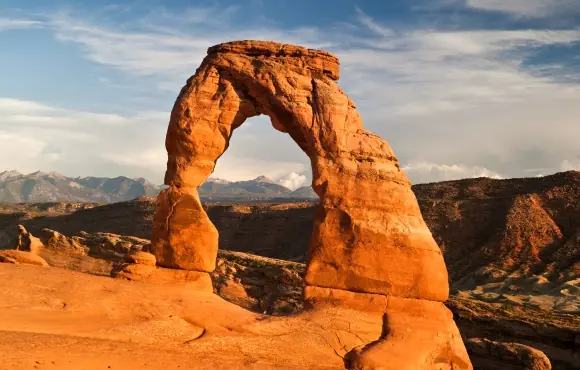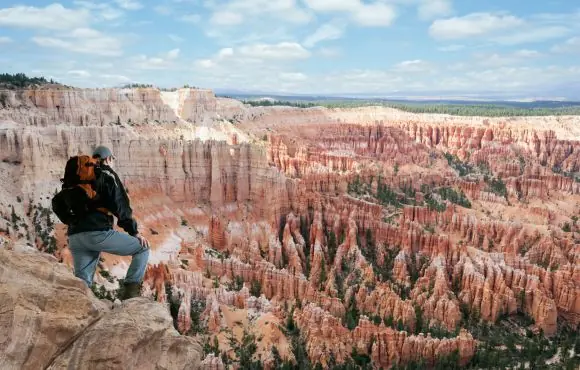Originally created as a National Monument in 1929, Arches was re-designated a National Park in 1971 and welcomes an average 1.07 million visitors a year. While it's one of the smaller national parks, Arches still offers a bounty of gorgeous scenery, diverse wildlife, unspoiled wilderness, excellent camping, hiking and more.
Because of its rather limited size the area can be busy during the summer season, so you should make your travel plans early.
World's Largest Collection of Sandstone Arches
1 of 10
Carved by centuries of relentless ice and wind, the towering salmon-colored arches have no equal anywhere in the world. From the world famous Delicate Arch to lesser-known formations that dot the park, Arches National Park will amaze and refresh you—especially at sunset.
Find a
CampsiteWildlife Galore
2 of 10
While the elusive desert bighorn sheep and mountain lions are the largest animals that call Arches home, other creatures can also be observed in the park, including toads, squirrels, falcons, foxes, mule deer, rattlesnakes and lizards.
If you're into plant life, you'll delight in the variety of vegetation that dominates the landscape. Among them are cacti, numerous types of grasses, pine trees, Utah juniper, Mormon tea, cliffrose and yucca.
Find a
CampsiteLimited Edition Campsites
3 of 10
Arches has a limited number of campsites—50 sites in total. Devils Garden Campground spots are usually reserved well in advance for the busy season (March to October), so showing up unannounced and finding a site is highly unlikely. Your best bet is to make a reservation online.
And if you can't get in at Arches, there are several other terrific campgrounds within easy driving distance.
The campground, which is open year-round, offers several amenities including potable water, picnic tables and grills, as well as both pit-style and flush toilets. Some sites can accommodate RVs up to 30 feet in length. You'll need to bring your own wood or charcoal for the grills.
Find a
CampsiteBackpacking
4 of 10
Because of its relatively small size, Arches offers little terrain for backpacking. To backpack, you'll need a backcountry permit available for free at the visitor center. The maximum group size is ten, but smaller groups are recommended. Permits may not be reserved in advance.
If you plan to backpack, you should know how to read a topographic map, recognize safety hazards, and practice low-impact camping. Be aware that there are no designated trails, campsites or reliable water sources outside the developed areas. Safety considerations include steep terrain, loose rock, lightning, flash floods and dehydration.
To learn more and for a map of permitted areas, you can download the Backpacking Brochure.
Find a
CampsiteThe Trails Await
5 of 10
Whether hiking is your passion or just something you do for fun, Arches provides a multitude of trails you can follow. These range from the strenuous 7.2-mile Devils Garden Primitive Loop that passes eight awe-inspiring arches, to the petite 100-yard Delicate Arch Viewpoint trail.
Be aware that daytime temperatures can reach or exceed 110 degrees F (43 degrees C) so bring at least one gallon of water per person per day.
Also note that intense thunderstorms are common between July and September, so take care when hiking on open rocky areas, as lightning presents a real danger. And because hard-packed sandstone makes up a large portion of the terrain, flash floods do occur.
Find a
CampsiteAwesome Biking
6 of 10
Bicycles are permitted on all paved and unpaved road within the park but not on trails. There are no bike lanes, so you must ride single file at all times with the flow of traffic. And while there are road signs to warn drivers that bikes might be present, you should remain alert to passing cars—the dramatic scenery can distract some drivers.
Find a
CampsiteAuto Touring
7 of 10
A scenic drive through Arches National Park will take you past many outstanding natural features. Be aware, however, that parking is extremely limited at all destinations and popular trailheads like Delicate Arch and Devils Garden. Weekends and holidays can be especially busy. Check the National Park Service's Traffic & Travel Tips for advice on making the most of your time, and how to avoid crowds.
Find a
CampsiteCanyoneering
8 of 10
Also known as canyoning, canyoneering is a sport in which you travel through canyons with the aid of climbing equipment for rappels and other technical descents.
Canyoneering in Arches does not require a permit unless the route is in Fiery Furnace or involves an overnight stay in the backcountry. Required permits are available at the visitor center on a first-come, first-served basis. Everyone in your group must be present at the visitor center to receive the permit.
Find a
CampsiteRanger-Led Programs
9 of 10
Park rangers and volunteers offer a variety of interpretive programs every day, spring through fall. Program types, times and locations will vary throughout the year and are subject to last-minute change due to weather or other factors. Check at the Arches Visitor Center upon arriving for more details.







Discuss This Article